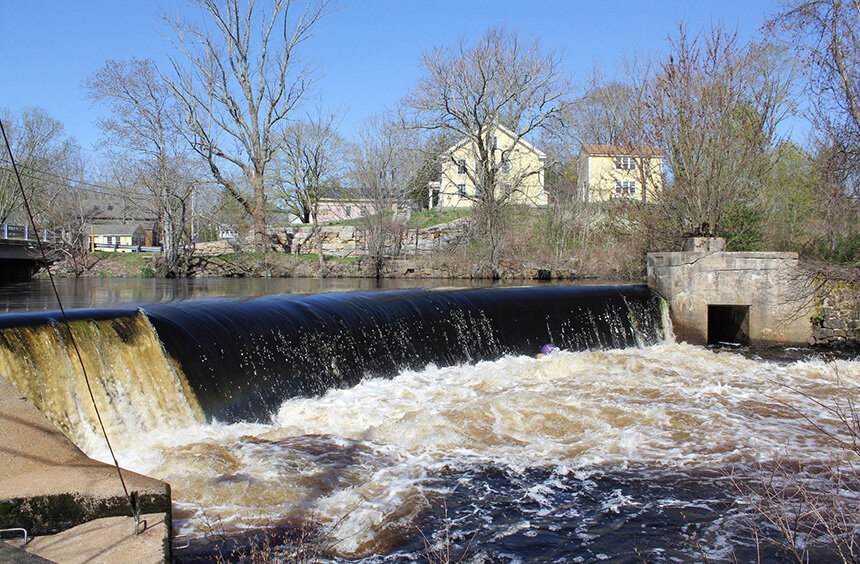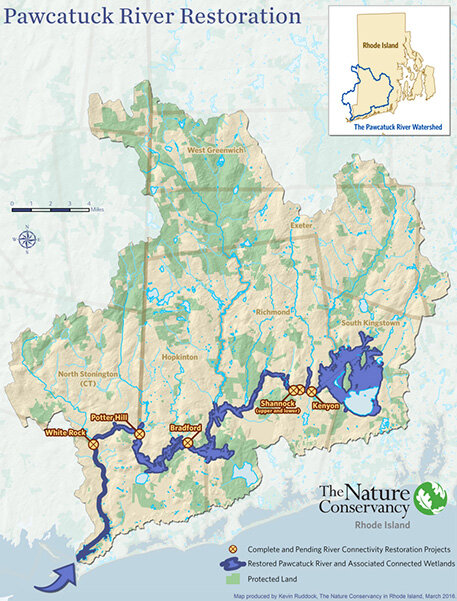By ecoRI News staff

The
work could lead to the partial or complete removal of the Potter Hill Dam in
Westerly, R.I. (TNC)
The
National Oceanic and Atmospheric Administration (NOAA) has awarded $100,000 to
the town of Westerly, R.I., to begin design and engineering work to improve
fish passage in the Pawcatuck River, which could lead to the partial or
complete removal of the Potter Hill Dam.
A
combination of town funds and contributions from The Nature Conservancy and the
Westerly Conservation Commission will match the NOAA grant.
Potter
Hill was one of 11 new projects to receive funding through NOAA’s Community-Based Restoration
Program, which supports fish habitat restoration and local
resilience efforts. Westerly’s proposal for Potter Hill was one of more than
100 other projects from across the United States and was the highest scoring
application in the Northeast.
As part of that effort, the firm will
assess the condition of the dam and its raceway, model anticipated changes in
river levels and floodplain, collect and analyze sediment samples, and
characterize potential effects on private properties, bridges, wetlands, and
other environmental conditions.
Project
planning is expected to take about a year to complete. During this phase, the
town will schedule public workshops, in partnership with the Wood-Pawcatuck
Watershed Association and the Southern Rhode Island Conservation District.

The
Potter Hill Dam is the last significant barrier to migratory fish passage on
the Pawcatuck River. Two dams have already been removed and fish passage
improved at three others.
NOAA
has approved an additional $750,000 for the project in future years, for
permitting and construction, pending the outcome of the planning phase.
“I’d
love to see the dam removed and allow for a free-flowing river once again,”
said John O’Brien, policy and partnership specialist for The Nature
Conservancy. “The engineers will look at a number of strategies for enhancing
fish passage at Potter Hill and come back with their recommendations, and then
we’ll go from there.”
Citing
flood risks in downtown Westerly and in Pawcatuck, Conn., municipal officials
and local stakeholders identified the Potter Hill Dam and the adjacent mill as
one of their highest priorities in an August 2019 community resilience workshop
organized by The Nature Conservancy and the Rhode Island Infrastructure Bank.
Last rebuilt in 1903, the dam and its raceway are failing, its water control
gates are inoperable, and the dilapidated mill is falling into the river.
The
Potter Hill Dam is the last significant barrier to migratory fish passage on
the Pawcatuck River. For nearly two decades various organizations and agencies
have worked to open the river for spring-migrating river herring, American
shad, and American eel.
The
Nature Conservancy and the US Fish & Wildlife Service led the removal of
the White Rock Dam (2015) and the Bradford Dam (2017). Prior to that, the
Wood-Pawcatuck Watershed Association and NOAA improved passage at Lower
Shannock Dam (2010), Upper Shannock Dam/Horseshoe Falls (2012), and Kenyon Mill
Dam (2013).